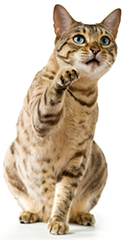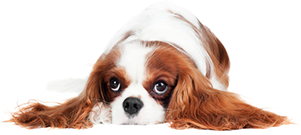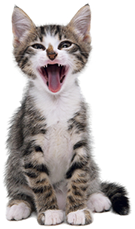Humane Pennsylvania believes that an educated caretaker makes for a better caretaker. Below we have provided some information on topics you may find useful.
 HOW TO DEAL WITH YOUR CAT’S CLAWS
HOW TO DEAL WITH YOUR CAT’S CLAWS
Your cat’s claws are his favorite tools, useful in self-defense, climbing, grooming and hunting, whether for real or just when he’s playing with a ball of yarn. Your job is to help him keep his claws in good shape, trimming them periodically and providing opportunities for sharpening them on sturdy, immovable scratching posts. If you like, you may cover the trimmed claws with soft nail caps, which come in a variety of colors.
Let’s start with trimming your cat’s claws, using a human toenail trimmer or a cat claw trimmer. Choose a time when you and your cat are relaxed. Wrap your left arm around your cat and hold her paw in your left hand, so you can clip with your right hand.* Place your left thumb on top of your cat’s toe and your forefinger beneath it. Gently squeeze to expose the claw.
When you look at the claw from the side, you’ll see the pink “quick” inside – and the curved hook that forms the end of the claw. With the trimmer in your right hand, cut off the claw’s hook. Avoid the quick to prevent discomfort. Pet and praise your cat as you trim each claw.
If you prefer to trim claws only occasionally, fit your cat with plastic claw caps like Soft Paws. To use them, trim your cat’s claws, apply a bit of the supplied glue to the inside of each cap and slide the cap onto the claw. Cuddle your cat for several minutes while the glue dries. As the claws grow over the next four to six weeks, the nail caps will drop off and you’ll need to repeat the process.
It’s also important to offer your cat scratching posts, because scratching is a normal cat behavior. The posts should be at least three feet high, so the cat can stretch while she scratches. It’s best to situate some posts vertically and others horizontally. The scratching posts must be stable, because cats don’t like posts that totter. Entice your cat to use each post by rubbing catnip on the surface and flicking a feather toy against it.
*If you are left-handed, reverse these directions: Hold your cat with your right arm and clip with your left hand.
 HOW TO CLEAN YOUR DOG’S EARS
HOW TO CLEAN YOUR DOG’S EARS
If your veterinarian recommends that you clean your dog’s ears – either because they are infected or to prevent infection – follow these simple steps.
Use the ear cleaner your veterinarian recommends, or, if your dog doesn’t have an ear infection, use an unmedicated pet ear cleaner. Medicated cleaners are not advisable for routine use, because they kill the “good” bacteria and allow “bad” bacteria and yeast to overgrow.
Hydrogen peroxide is not a good ear cleaner because it forms oxygen and water, which leaves the ear canal moist, inviting bacterial growth. Don’t use alcohol, either, as it stings if the ear canal is inflamed.
Dogs’ ear canals are L-shaped internally, so the first step in cleaning is to straighten the “L” by gently raising the ear flap as far as it will go.
Fill the ear canal with cleaner, and massage the base of the ear to loosen any debris inside the canal. Let go of the ear and let your dog shake his head. The debris will move from deep in the canal up to the ear flap where you can remove it easily with gauze, cotton balls or tissues.
Don’t insert a cotton swab into your dog’s ear canal, because you might push debris deeper into the canal or damage the eardrum.
Finally, give your dog lots of praise while you clean his ears – and a dog treat, too, if he’s especially good – so he always will be happy to have his ears cleaned.
 DENTAL CARE
DENTAL CARE
Dogs and cats benefit from good dental care, just as people do. Good dental habits begin early and include a healthy diet (preferably of dry food), regular tooth brushing, an annual physical examination to detect minor dental problems before they progress to major ones, and professional teeth cleaning when needed.
The benefits of good dental care include more than sweet-smelling breath. Healthy teeth and gums decrease the risk of heart, kidney and liver disease, because bacteria in diseased gums travel through the bloodstream to these organs. In addition, good dental health reduces the need for tooth extractions.
Signs of dental disease include bad breath, gingivitis (a red gum line which may actually shrink back from its usual position), loose teeth and decreased interest in food that requires chewing. Some pets even become lethargic as their mouths become more painful.
One of the best ways to maintain good dental health is to brush your pet’s teeth. Start by softening the bristles of an ordinary soft toothbrush with warm water and applying pet toothpaste to the brush. Pet toothpastes, which are flavored to appeal to pets, contain enzymes that are specific to the chemistry of the dog and cat mouth. Human toothpastes are not recommended because they are ineffective, foam too much and cause stomach upset when pets swallow them.
Gently brush the cheek surfaces of the incisors, the front-most teeth. Over the next few sessions, extend the toothbrush further back in the mouth, so that eventually all teeth are brushed. The animal’s tongue removes much of the plaque from the inside surfaces of the teeth, so your brushing should focus on the cheek surfaces of the teeth, where most of the plaque forms. Tooth brushing is most effective if done daily, but every-other-day brushing also is beneficial.
Professional cleaning, when needed as a supplement to brushing, is done under general anesthesia. The crowns of the teeth are cleaned with an ultrasonic scaler, and the portions of the teeth under the gums are hand-scaled to remove plaque that would otherwise damage the gums. The teeth are polished to produce a smooth surface to which plaque cannot easily attach. Finally, a plaque prevention barrier is applied. Teeth are extracted only if necessary to ensure the health of the rest of the mouth. If needed, x-rays are taken and antibiotics are prescribed. The first meal after the procedure should be light. If teeth were removed, your pet may prefer soft foods for this meal.
Good dental care keeps your pet’s mouth sweet-smelling and free of pain – and helps the rest of your pet’s body remain healthy, too.
